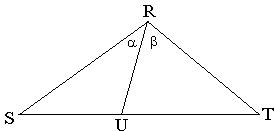2N-Wing Butterfly Problem
This is an illustration of the 2N-Wing Butterfly problem that is discussed below.
| What if applet does not run? |
2N-Wing Butterfly Theorem
Observe a 2N-wing butterfly cradle. Let M denote the nexus. Assume the spikes are crossed by the circles in points AN, ..., A1, (M), B1, ..., BN and CN, ..., C1, (M), D1, ..., DN, respectively. Let p be any permutation of the index set
|
Note that for N = 1 the theorem reduces to (A). The proof depends on two lemmas.
Lemma 1

Let in ΔRST, RU be a cevian through vertex R. Introduce angles a = ∠SRU and b = ∠URT. Then
|
The proof is a two-liner that follows from the identity
| Area( ΔRST) = Area( ΔRSU) + Area( ΔRUT). |
Lemma 2 is a curious result in its own right.
Lemma 2

|
|
Assume three rays C, B, and Y emanate from point M with Y between C and B. Assume also that, for N > 1, points C1, ..., CN have been marked on C, while points B1, ..., BN have been marked on B. Let p be any permutation of indices |
The proof builds on Lemma 1 which is applied to each of the triangles MCiBp(i):
| (3) | sin(b + g)/MYi = sin(g)/Bp(i) + sin(b)/MCi, |
g and b are the angles CMY and YMB, respectively. Add up all the identities (3). After rearranging the terms, we'll get
| (4) | sin(b + g)(1/MY1 + ... + 1/MYN) = sin(g)(1/B1 + ... + 1/BN) + sin(b)(1/MC1 + ... + 1/MCN), |
| in which the right hand side does not depend on the permutation p. The same therefore is true for the left hand side. |
Proof of Theorem
The proof easily follows from Lemma 2 by pidgin, or is it pigeon, induction (if a statement holds for
| 1/MS1 + ... + 1/MSN = 1/MT1 + ... + 1/MTN. |
But due to Lemma 2,
|
1/MS1 + ... + 1/MSN = 1/MX1 + ... + 1/MXN, while 1/MT1 + ... + 1/MTN = 1/MY1 + ... + 1/MYN, |
| and the result follows. |
Remark
The theorem raises further questions. Each permutation can be represented as a product of irreducible cycles. It must be obvious that every such cycle is responsible for forming a unique butterfly. If the permutation is cyclic, the theorem yields a lone insect. However, in general, the N pairs of wings are split between a number of butterflies, one per an irreducible cycle that compose the permutation. This is an open question whether the butterflies are just stuck on top of each other and could be in principle separated, or whether their wings are so entangled that no separation is possible.
L. Bankoff was amazed with a fantastic variety of solutions to the Butterfly problem -- "some by Desargues' theorem on involution, some by the use of cross ratios, others stemming from Menelaus, analytic geometry, trigonometry, advanced Euclidean geometry, and various other modalities ..." May the braids theory hold the answer to the problem of separation of the entangled butterflies.
Butterfly Theorem and Variants
- Butterfly theorem
- 2N-Wing Butterfly Theorem
- Better Butterfly Theorem
- Butterflies in Ellipse
- Butterflies in Hyperbola
- Butterflies in Quadrilaterals and Elsewhere
- Pinning Butterfly on Radical Axes
- Shearing Butterflies in Quadrilaterals
- The Plain Butterfly Theorem
- Two Butterflies Theorem
- Two Butterflies Theorem II
- Two Butterflies Theorem III
- Algebraic proof of the theorem of butterflies in quadrilaterals
- William Wallace's Proof of the Butterfly Theorem
- Butterfly theorem, a Projective Proof
- Areal Butterflies
- Butterflies in Similar Co-axial Conics
- Butterfly Trigonometry
- Butterfly in Kite
- Butterfly with Menelaus
- William Wallace's 1803 Statement of the Butterfly Theorem
- Butterfly in Inscriptible Quadrilateral
- Camouflaged Butterfly
- General Butterfly in Pictures
- Butterfly via Ceva
- Butterfly via the Scale Factor of the Wings
- Butterfly by Midline
- Stathis Koutras' Butterfly
- The Lepidoptera of the Circles
- The Lepidoptera of the Quadrilateral
- The Lepidoptera of the Quadrilateral II
- The Lepidoptera of the Triangle
- Two Butterflies Theorem as a Porism of Cyclic Quadrilaterals
- Two Butterfly Theorems by Sidney Kung
- Butterfly in Complex Numbers
Desargues' Theorem
- Desargues' Theorem
- 2N-Wing Butterfly Problem
- Cevian Triangle
- Do You Speak Mathematics?
- Desargues in the Bride's Chair (with Pythagoras)
- Menelaus From Ceva
- Monge from Desargues
- Monge via Desargues
- Nobbs' Points, Gergonne Line
- Soddy Circles and David Eppstein's Centers
- Pascal Lines: Steiner and Kirkman Theorems II
- Pole and Polar with Respect to a Triangle
- Desargues' Hexagon
- The Lepidoptera of the Circles
|Activities| |Contact| |Front page| |Contents| |Geometry|
Copyright © 1996-2018 Alexander Bogomolny
71596928
